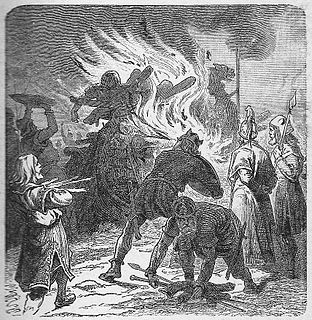In Ragnarssona þáttr , Helgi the Sharp, prince of Ringerike (Old Norse: Helgi Hvassi) was a grandson of king Ring II of Ringerike and the brother of Guðrøðr, the king of Ringerike and they lived in the 9th century.

Old Norse was a North Germanic language that was spoken by inhabitants of Scandinavia and their overseas settlements from about the 9th to the 13th century.
Ring II, was a mythical king of Ringerike. He was the son of a king of Ringerike and father of king Gudrød of Ringerike and prince Helgi the Sharp.

Ringerike is a traditional district in Norway, commonly consisting of the municipalities Hole, and Ringerike in Buskerud county. In older times, Ringerike had a larger range which went westward, to the municipalities Krødsherad, Modum, and Sigdal, also in Buskerud.
Ragnar Lodbrok's sons Sigurd Snake-in-the-Eye, Björn Ironside and Hvitserk had raided in France and after Björn had gone home to Sweden, his brothers were attacked by emperor Arnulf of Carinthia. In the battle 100,000 Danes and Norwegians fell, including Sigurd Snake-in-the-Eye and king Guðrøðr.

Ragnar Lodbrok or Lothbrok was a historically dubious Norse Viking hero and legendary king of Denmark and Sweden, known from Viking Age Old Norse poetry and sagas. According to that traditional literature, Ragnar distinguished himself by many raids against Francia and Anglo-Saxon England during the 9th century. There is no evidence that he existed under this name and outside of the mythology associated with him. According to the Tale of Ragnar Lodbrok, Ragnar was the son of the Swedish king Sigurd Hring.
Sigurd Snake-in-the-eye was a Viking warrior in the middle of the 9th Century. According to The Tale of Ragnar Lodbrok he is one of the sons of the legendary Viking Ragnar Lodbrok.

Björn Ironside was a historical Norse Viking chief who also figures in late sources as a son of Ragnar Lodbrok and a legendary king of Sweden. He lived in the 9th century, being securely dated between 855 and 858. Björn Ironside is said to have been the first ruler of the Swedish Munsö dynasty. In the early 18th century, a barrow on the island of Munsö was claimed by antiquarians to be Björn Järnsidas hög or Björn Ironside's barrow.
Helgi escaped from the battle with Sigurd Snake-in-the-Eye's banner, sword and shield. He went to Denmark and informed Sigurd's mother Aslaug of her loss. Since the next king, Harthacnut, was still too young to rule, Helgi stayed in Denmark as its regent. There, Helgi married Harthacanute's twin sister, also named Aslaug, and they had the son Sigurd Hart. [1]

Aslaug, also called Aslög, Kráka or Kraba is a queen consort in Norse mythology who appears in Snorri's Edda, the Völsunga saga and in the saga of Ragnar Lodbrok as his third wife.
Sigurd Hart or Sigurd Hjort was a legendary king of Ringerike, during the late 9th or early 10th centuries. he is mentioned in Ragnarssona þáttr and in Halvdan Svartes saga.



